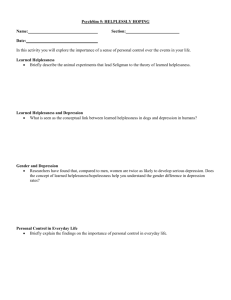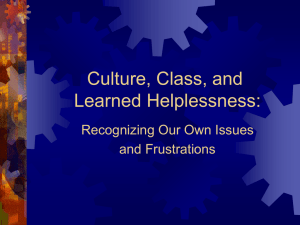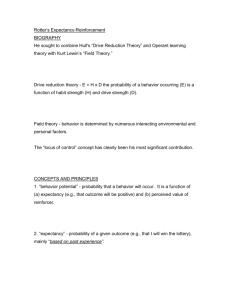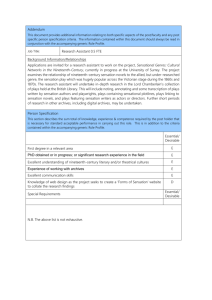A. Julian Rotter: Locus of Control
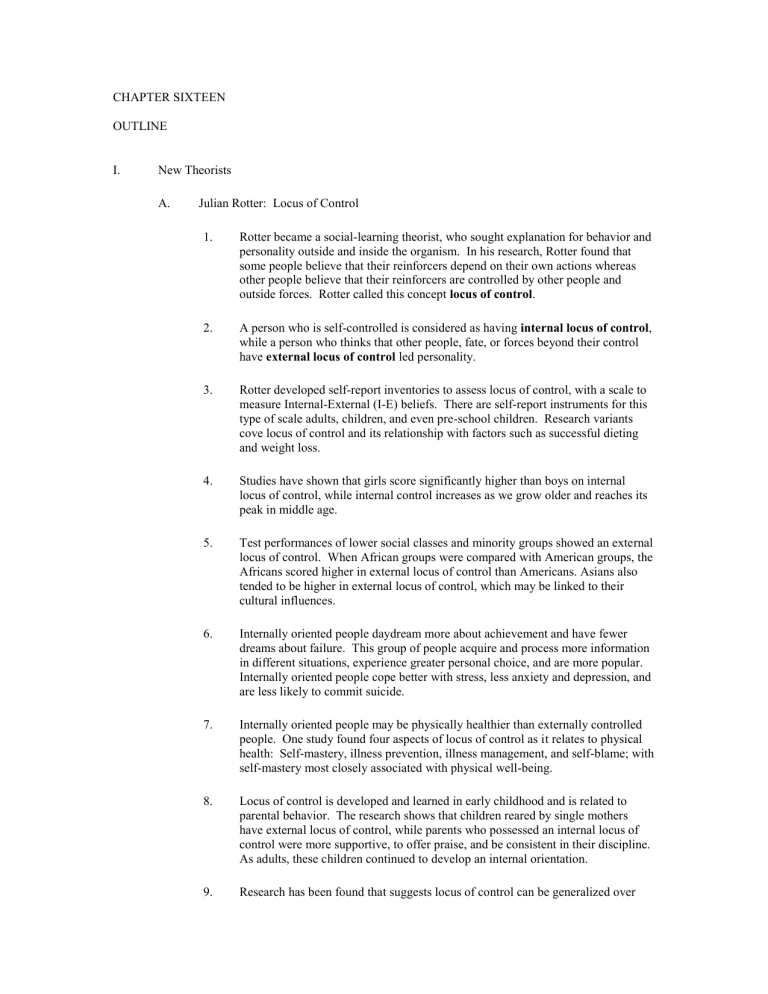
CHAPTER SIXTEEN
OUTLINE
I.
New Theorists
A.
Julian Rotter: Locus of Control
1.
Rotter became a social-learning theorist, who sought explanation for behavior and personality outside and inside the organism. In his research, Rotter found that some people believe that their reinforcers depend on their own actions whereas other people believe that their reinforcers are controlled by other people and outside forces. Rotter called this concept locus of control .
2.
A person who is self-controlled is considered as having internal locus of control , while a person who thinks that other people, fate, or forces beyond their control have external locus of control led personality.
3.
Rotter developed self-report inventories to assess locus of control, with a scale to measure Internal-External (I-E) beliefs. There are self-report instruments for this type of scale adults, children, and even pre-school children. Research variants cove locus of control and its relationship with factors such as successful dieting and weight loss.
4.
Studies have shown that girls score significantly higher than boys on internal locus of control, while internal control increases as we grow older and reaches its peak in middle age.
5.
Test performances of lower social classes and minority groups showed an external locus of control. When African groups were compared with American groups, the
Africans scored higher in external locus of control than Americans. Asians also tended to be higher in external locus of control, which may be linked to their cultural influences.
6.
7.
Internally oriented people daydream more about achievement and have fewer dreams about failure. This group of people acquire and process more information in different situations, experience greater personal choice, and are more popular.
Internally oriented people cope better with stress, less anxiety and depression, and are less likely to commit suicide.
Internally oriented people may be physically healthier than externally controlled people. One study found four aspects of locus of control as it relates to physical health: Self-mastery, illness prevention, illness management, and self-blame; with self-mastery most closely associated with physical well-being.
8.
Locus of control is developed and learned in early childhood and is related to parental behavior. The research shows that children reared by single mothers have external locus of control, while parents who possessed an internal locus of control were more supportive, to offer praise, and be consistent in their discipline.
As adults, these children continued to develop an internal orientation.
9.
Research has been found that suggests locus of control can be generalized over
B.
Marvin Zuckerman: Sensation Seeking
1.
In the 1970’s, Marvin Zuckerman conducted research on personality called, sensation seeking . He described this trait in people by a desire for the sensational, to have intense sensations and experiences, and the willingness to take a physical, social, legal, or financial risk for the sake of having the experience.
2.
many situations whereas Bandura’s concept of self-efficacy tends to be more specific to a particular situation. Studies have continued to give Rotter’s theories considerable empirical support and locus of control has become one of the most studied variables in psychology.
Zuckerman used a method to measure this trait by the Sensation Seeking Scale
(SSS), a 40 page paper-and-pencil questionnaire. When Zuckerman was developing the test, he had what he described as sensation seekers as a job, such as a firefighter or policeman with those people who chose to avoid novel or risky activities. Zuckerman identified four components using factor analysis to identify sensation seeking. They are, (1) thrill and adventure seeking, (2) experience seeking, disinhibition, and boredom susceptibility.
3.
4.
5.
Research shows that high sensation seekers were more likely than low sensation seekers to experiment with illicit drugs, alcohol use, marijuana use, as well as the behaviors of drug selling and shoplifting. The high sensation seekers were more likely to smoke cigarettes, drink alcohol, drive fast, have more car accidents and convictions for reckless of drunken driving, and engage in frequent sex, in a study of groups in the United States. Physical risk-taking behavior has been related to sensation seeking. Other research suggests that those who are seen as anti-social risk takers or as adventurous risk-takers scored high on sensation seeking even over those who took risks for a living, such as firemen and policemen.
High sensation seekers do not relate to other people in a dependent or nurturing way. However, high scorers for sensation seeking were not correlated with abnormal or neurotic behavior. Those low in this scale may have neuroses such as phobias and obsessive-compulsive behaviors. High scorers openly express their emotions and act independently of social conventions and other people’s needs and attitudes.
High sensation seekers were found to recognize symbols and figures more quickly and preferred greater visual stimulation than did low sensation seekers. However, tests of creativity and originality revealed that high sensation seekers have a greater capacity for original thinking but do not always express it in their schoolwork. Zuckerman suggested that because high sensation seekers continually search for novel experiences, if they cannot find them in external situations they look inward and create a fantasy world.
6.
7.
High sensation seekers prefer stimulating and varied experiences and scored high in scientific interests and negatively with clerical interests. The high sensation seekers of both sexes preferred risky, cutting-edge jobs such as crisis intervention work or paramedic duty on emergency response teams.
Studies of twin-comparisons show a strong hereditary basis for a sensationseeking personality factor; however Zuckerman recognized the influence of
C.
8.
situational or environmental factors. Scores of first-borns and only-borns rate high in sensation seeking. This may be the fact that first-borns and only-borns may receive greater stimulation and attention from parents at an early age.
Sensation-seeking theory is easy to accept in that people tend to differ in their need for excitement and risk, change and adventure.
Martin E. P. Seligman: Learned Helplessness
1.
Seligman began research in the mid-1960’s on a limited-domain aspect of personality he calls learned helplessness . Seligman observed this phenomenon in the laboratory with dogs. Using aversive high pitched sounds with electric shock, he conditioned the dogs. However, when he did the experiment where the dogs had to jump a low wall to avoid the shock, the dogs did not cross to escape the shock. The dogs lay down, whimpered, and made no effort to escape. The dogs were conditioned to the first shock of the experiment and may not have jumped the barrier because they sensed they would be shocked anyway. This learned reaction probably generalized to the second part of the experiment, even though a means of escape was available.
2.
Seligman demonstrated learned helplessness in not only dogs, but with people.
The experimental participants of the study were given some loud tones in which they were to press a series of buttons in the correct order to stop the tones.
However, there was no correct sequence that they could push to stop the loud tones. In the control group, there was a relatively easy sequence to follow to turn of the tones. In the next experiment, both groups were placed in a situation where they could learn a new sequence with their hands to turn off the tones. The control group rapidly learned the sequence but the experimental research participants sat passively, making no effort to turn off the irritating noise.
Learned helplessness effects have been found in adult men and women, college students, adolescents, children, elderly persons, and patients in psychiatric hospitals.
3.
Learned helplessness has been observed in the elderly. A study of elderly residents in a nursing home who were given more freedom and more choices to run their daily lives were happier and more physically active than those residents who had no personal influence or responsibility over their daily lives. Even after
18 months, the differences persisted.
4.
There have been widespread findings on the beneficial effects of having control over one’s life in marital satisfaction, personal adjustment, and increased feelings of being in control of their lives.
5.
Seligman and his associates studied rats with tumors. They conditioned some of the rats for learned helplessness and other rats for some measure of control over their own behavior. The rats that had some level of control had better rates of survival from the tumors. Learned helplessness was also shown to weaken the rat’s immune system. These findings may provide a physiological explanation for the result that the helpless rats were unable to reject their tumor.
6.
Explanatory style is a way of explaining to ourselves our relative lack of control over our environment. An optimistic explanatory style prevents helplessness, while a pessimistic explanatory style spreads helplessness to all facets of life.
D.
7.
8.
According to Seligman, people who are optimistic tend to be healthier, where pessimists tend to believe that their actions are of little consequence. Findings of research also show that optimists live longer than pessimists. The optimist copes with AIDS and felt more in control of their lives. However, an optimist may believe that they may not get AIDS because of their attitudes about life. This belief system may not keep them from having this disease, but this optimistic thinking may help patients cope better and minimize depression over a major illness, such as AIDS. Optimism has been found with intensity of one’s own religious beliefs. Fundamentalists scored higher on measures of optimism and had
“more hopefulness and less hopelessness.” American research participants had higher scores of optimism that their Asian counterparts. Americans could predict that positive things would happen to themselves, while Asians predicted positive things would happen to other people. Those scoring high in optimism have less stress and depression and in student populations earn better grades. Optimism may affect our cognitive function. Optimist may have unrealistic views about their invulnerability to the effects of their behavior. However, the pessimist when facing adversity, such as a serious illness may tell themselves they will not be able to cope or overcome the situation.
Seligman’s research found several similarities between the symptoms of depression and the characteristics of learned helplessness. Depression is associated with poor health and puts people at risk for physical illness by reducing the effectiveness of the immune system, suppressing NK cell activity, and altering white blood cell count. Seligman’s research supports his hypothesis that learned helplessness leads to depression in people with a pessimistic explanatory style.
According to Seligman, some people appear to give up, become depressed, and experience health problems, while others, facing similar circumstances recover over a period of time. Seligman proposed a cognitive explanation for these differences, a revised concept of learned helplessness called the attribution model . Attribution suggests we attribute our failures to our lack of control over our selves. Pessimists attribute failure to internal, stable, and global causes whereas optimists attribute failure to external, unstable, and specific causes. If you can’t change the cause of your failure, it is stable, while if you make a global attribution, you are saying that whatever caused you to fail that course is likely to cause you to fail in other courses. Overall, researchers concluded that the pessimists responded to negative events and problems passively and made few attempts to alter their circumstances.
9.
Seligman believed we are more vulnerable to feelings of learned helplessness in infancy and early childhood. Infants begin in total helplessness, but mature to cry for their needs and to exercise control. A child will have numerous interactions with helplessness and their ability to control and overcome these feelings. If they do not have successful outcomes, there may be an increase in overall feelings of learned helplessness. Learned helplessness can be learned later in childhood by brutality by peers, a harsh school environment, or other negative experiences.
Other factors, such as race or poverty or how a student is treated as less intelligent or less skilled can lead to learned helplessness.
Martin E. P. Seligman: Positive Psychology
1.
Positive psychology deals with happiness, excellence, and optimal human functioning. Psychologists have labeled the happy personality in terms such as subjective well-being or life satisfaction and define it as the cognitive evaluation
2.
3.
of the quality of one’s own life experience and the possession of positive affect.
Research shows that an adequate income to fund basic needs is a necessary, though not sufficient prerequisite for happiness. Health appears to be a necessary but not sufficient condition for subjective well-being. In research, there is a strong positive relationship between life satisfaction and an orientation toward the future. Also, studies show that subjective well-being does not decline with age.
The elderly who had stronger social networks and supportive friends reported higher levels of happiness than those who were more socially isolated. Married people report higher levels of happiness than people who are divorced, separated, widowed, or who have never married. Those people who had experienced discrimination reported lower levels of life satisfaction than those who had experienced no discrimination.
There has been research done on the personality correlates of the happy personality, particularly with the Big Five Factors and with Eysenck’s three personality factors. In several studies in different countries the researchers found that low neuroticism and high extraversion correlated significantly with national levels of subjective well-being. Self-efficacy and internal locus of control are positively related to life satisfaction.
A meta-analysis which includes six variables associated with the happy personality was done with over 148 studies and 42,000 research participants. The findings show (A) if a person does not deny or avoid that negative experiences can happen to them, they will have a higher score in their subjective well-being, while, (B) people who score high in trust report greater life satisfaction, (C) and those who have an internal locus of control score high in well-being. A person, who is (D) hardy , tends to minimize the effects of stressful events by adapting to and evaluating them in optimistic terms, while a person who rates high in emotional stability , positive affect and self-esteem score high in subjective wellbeing. Two large studies found significant differences in the ways in which happy and unhappy people perceive, judge, or construe events in their lives.
